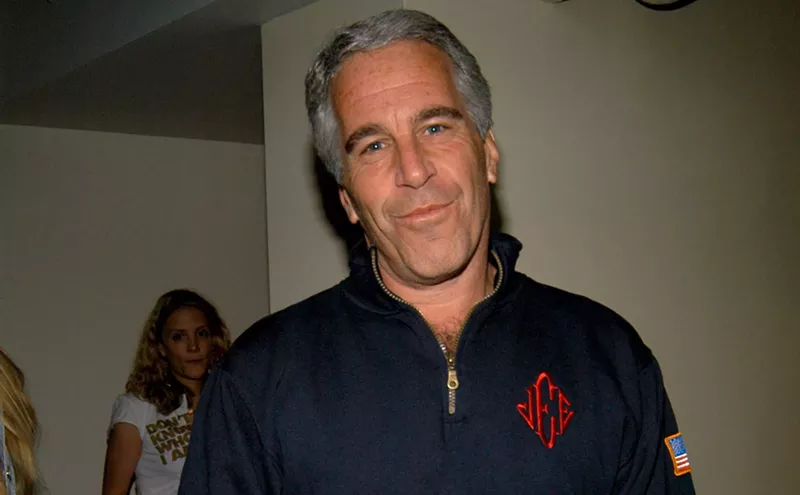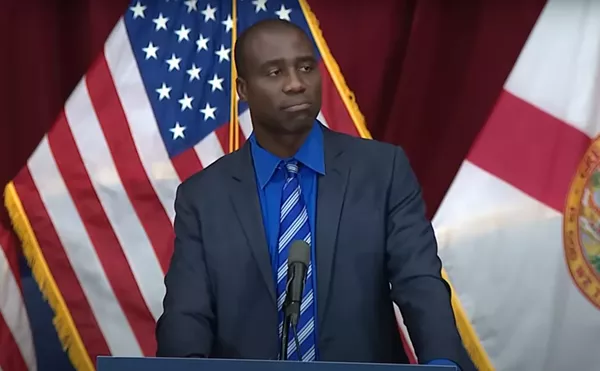For nearly 30 years Whittaker headed the Dade County Sheriff's Office Crime Laboratory Bureau (now the Miami-Dade Police Department Crime Laboratory). There he analyzed all kinds of evidence -- bloodstains, semen traces, fingerprints, skeletal remains, bullet and gunpowder markings, bomb fragments, poison residues, and other gruesome evidence of murder, assault, rape, and general mayhem. But that was only half the job. He then rendered opinions of his findings in court to bring suspected criminals to justice. He has testified an astonishing 3200 times.
Whittaker has witnessed the very worst that one person can do to another and is an ardent advocate of capital punishment. A primary purpose of police departments and crime labs, he says with a hard gleam in his eye, is "to identify the bad guy, take him to court, and then burn his butt." Yet here's a seasoned police veteran who also says he'd rather see murderers and rapists go free than stand by while even one innocent person is wrongly convicted. When he retired from the crime lab in 1986, he hung out his shingle as a freelance criminalist, and these days he offers expert testimony for the defense in cases he believes result from shoddy police work or overeager prosecutors.
A Miami resident, Whittaker is a youthful-looking 76 years old. His handshake is firm and his eyes are sharp, even though he lost most of the vision in his right eye after a childhood baseball accident. He brightens when he talks about his favorite topic: evidence. "It's fun," he says, flashing a warm smile. "You work the evidence and sometimes something pops up pretty quick, but other times you have to sweat it out and work it hard. In most cases, though, the answer does come out." Whittaker has lived alone since a divorce 24 years ago. Two daughters he seldom sees live in California. He sometimes visits another daughter, who lives in south Dade, in what he calls "avocado country." He has no hobbies and engages in few activities other than reading scientific and technical journals. His one passion is solving evidence puzzles -- for him, it's the straw that stirs the drink.
Whittaker is one of just a handful of professional criminalists working in South Florida today. Despite the fact that he can earn up to $1400 per day, plus expenses, he turns down most cases. "I've probably been called on about 300 cases in twelve years," he says, "but I accepted only 21, based on being told vigorously about the physical evidence. I nail down these [attorneys] when they try to give me gobbledygook. Give me some answers instead. What kind of evidence was recovered? Who ran it? In what crime lab? What does the lab report say? If the evidence shows that X, Y, and Z occurred, I put it together in my head and say it's a lock: 'These guys don't make that kind of mistake on that kind of evidence. And since the evidence is against your client, I can't help you.' It's that simple."
Getting Whittaker to talk about those cases he has accepted is easy. His side has won all of them, for one thing. A prominent example: the case of Merry Pease, a Virginia housewife charged with shooting and killing her husband in 1993. Pease, who suffered a serious gunshot wound in the incident, claimed that her husband shot her and then killed himself. The prosecution, however, maintained that she shot her husband twice, then turned the gun on herself to appear the victim.
Pease's attorney contacted the American Academy of Forensic Sciences, the largest and most prestigious body of forensic scientists in the world, for the name of an expert who might testify on her behalf. He was referred to the academy's former president: Ed Whittaker.
"Merry had been shot just through the midline to the left of her navel," Whittaker recalls, thumbing through the case file. "It was almost a straight-through shot, with the bullet going through her abdominal muscle, liver, pancreas, stomach, kidney, and then exiting near the backbone. The prosecutor was calling it a self-inflicted alibi gunshot wound. The case was the biggest joke I'd ever seen in my life."
Self-inflicted alibi gunshot wounds are extremely rare, he explains in his easy but authoritative manner. "I did a lot of checking, put notices on [computer] bulletin boards, and contacted homicide dicks around the country. I asked for any information about self-inflicted alibi gunshot wounds. The only report I got back was from Mike Gonzalez [former head of the Miami Police Department's homicide unit]. He had one case where the bad guy killed this other man, then pinched himself above his belt, pulled the skin out like a little flap, held it, and fired a shot though it. Mike said everybody was fooled until the doctor who treated the guy called police and said there was something wrong with the injury."
Merry Pease's wound, according to Whittaker, was life-threatening, not an alibi wound. "She spent two weeks in intensive care on a respirator at the University of Virginia hospital. Merry Pease no more shot her husband than I did," Whittaker says, shaking his head disdainfully. "So I agreed to take the case."
Wise, Virginia, is a small coal-mining town in the southwestern part of the state, home to only a few thousand people. Merry lived there in a trailer with her husband Dennis and her two young children from a previous marriage. Dennis was an engineer in charge of a shift at the local coal mine.
"The husband had been complaining to his buddies at work about problems with his marriage," Whittaker recounts. "He'd get off from work and be home around 8:00 a.m, and he'd sit around and start drinking. One day he tried to suffocate Merry with a pillow, but she fought him off. She could do so because she was about five feet eight and 160 pounds, just about his size. But she didn't bring charges. You don't do that in a little community like Wise. Her attitude was he just got a little carried away.
"Then one day he told his closest buddy at work, 'Things have come to a head -- today's the day.' He went home and began drinking. Around noon Merry saw him in the driveway, working on the car with the hood up. Then early in the afternoon he tries the pillow game on her again, and this time he's pretty serious because the pillow's ripped up and feathers go everywhere."
Merry was able to get away from her husband, who retreated to the bedroom and shut the door. "Sometime later she goes out to pick up the kids from school," Whittaker continues. "She tries and tries, but the car won't start, and she remembers that she saw her husband fiddling with it earlier. He's immobilized her. Later, it turns out, he also pulled the wire out of the phone.
"She went into the trailer and said to her husband, 'Dennis, the car won't start. I have to go get the kids now.' After that her recollection of the events that followed became murky and confused. But it's always difficult to try to remember things in the heat of emotion."
As Whittaker reviewed the evidence, he was able to reconstruct the events that took place in the trailer: Dennis opened the bedroom door and Merry saw a .357 Magnum swinging toward her. "She instinctively grabbed the barrel as he shot her," he says. "I don't think she ever let go of the gun. She was able to push it down a few inches to miss the heart, and that probably saved her life. She was his size, a strong woman. Her heart was pumping, and he was drunk. They struggled from the bedroom across the kitchen to the living-room entrance."
Merry then ran out of the trailer, according to Whittaker, and down to the roadway to try to flag down passing vehicles. Nobody would stop. "She ran over to the trailer home of her neighbors. She was screaming, 'My husband shot me! My husband shot me!'
"By this time she was a real mess, with blood and gunpowder all over herself," Whittaker goes on. "The neighbors gave her a rag and she wiped her face and hands. At this point one neighbor noticed that she had a dark smudge on the heel of her right hand. Merry tried to wipe it off with a wet rag but it wouldn't come off. It was a burn, and she got it because the heel of her hand was against the cylinder of the gun when the shot was fired."
Whittaker believes her husband was watching her from the bedroom window. "He gets mad standing there and rips the curtains and venetian blinds out of the window and throws them across the bed. He then walks into the kitchen and shoots himself near his right nipple. The bullet goes between the ribs, hits a lung, and exits out his back."
But Dennis didn't die then, Whittaker maintains. He wandered through the house, dripping blood, and finally entered the living room, where he shot himself again, this time through the heart, fracturing a rib in the process. He bled to death on the floor, says the criminalist. But the prosecutor charged that Merry had shot her husband first in the bed -- even though there was no bullet hole in the bed, and no blood on the bed. He also charged that Merry shot her husband a second time in the living room, killing him.
Whittaker testified that the extensive trail of blood drops and spatters, along with 144 death-scene photographs and two videotapes re-creating the events, conclusively proved that Dennis shot and tried to kill his wife, who deflected the shot with her hand. The prosecution's theory made no sense, he argued.
But for Merry Pease, things went from bad to worse. A jury found her guilty of second-degree murder and she was sent to the county jail to await sentencing. For eleven months she languished in a cell, waiting for J. Robert Stump, the judge in the case, to summon her back to court.
Whittaker had done his best and received his fee. But this was a case he couldn't turn his back on. So while Pease's new attorney, Gerald Gray, pursued an appeal, Whittaker went back to work, this time for free. He wrote Judge Stump and asked for permission to make a presentation of the evidence before sentencing. Stump ignored him.
The judge finally scheduled Pease's sentencing for the last week of July 1995. "I was aware that in Virginia the governor appoints the judges," Whittaker says today. "So a few days before Merry's sentencing, I took out a quarter-page ad in the Richmond Times-Dispatch, where I was sure the governor would see or hear of it." The ad, which cost Whittaker nearly $4000 of his own money, took the form of an open letter to the governor and attorney general. In it he laid out the facts and evidence in the case. Pointing out that Pease was due for sentencing in a few days, he wrote that she had "committed no crime.... Her crazed, drunk, raging husband fired a bullet nearly through the center of her body and then killed himself. Dennis committed the only crime and the people of Virginia are putting Merry in jail!" He asked the governor to suspend Pease's sentencing until evidence in the case could be studied by Virginia's top forensic scientists.
On July 27, 1995, Stump sentenced Pease to fifteen years in the state penitentiary (a 23-year sentence with ten years suspended, plus a mandatory two years for commission of a felony while using a firearm). Then the judge did something highly unusual: He let Pease, now a convicted murderer, go free on bond while her new attorney prepared an appeal.
Did Whittaker's letter to the governor help Pease walk out of jail? He thinks so. "I'll bet you $50,000 some kind of communication took place between the capital and this little town of Wise, Virginia," Whittaker says with a wink and a smile.
While Pease was home with her children, her attorney was able to get her conviction reversed on the basis of prosecutorial misconduct. She was later indicted again for murder, but eventually the charge was dropped. Pease is convinced that Ed Whittaker played an important role in her fight for justice. "I think without Ed's help I might be in prison now, I really do," she says today. "Ed did all that work for free because he believed in me. There are so many innocent people in jail right now who don't have someone working for them. If they don't have an advocate on the outside, they stay there."
Last year Whittaker was instrumental in helping get felony charges dropped against Edson Mejia, a Miami man in his late twenties. It was a supremely goofy case, according to Whittaker, with Mejia shot in the head but arrested by Miami police for attempted murder.
In late September 1996, according to Whittaker, the 28-year-old Mejia was trying to break up with his girlfriend, Karen Matamoros, age 20. He met with her one last time, then drove her to her home near NE 24th Street and Fourth Avenue in Miami. Only those two people can say with certainty what happened after the meeting, but Mejia very nearly bought a bullet in the brain.
"It was the final kiss-off," says Whittaker. "She was highly pissed. She was in the act of getting out of the passenger's door. She had the door open, and she probably had her head and body completely outside of the car. She reached down and, with her right hand, took a Raven .25 caliber semiautomatic out of her purse. She then spun around to fire."
Mejia saw the gun and quickly dived straight across the car and hit or grabbed Matamoros's hand, Whittaker says. "I'm sure the weapon discharged from outside the vehicle," he explains, "because there were no powder patterns or gunshot residue inside." The bullet tore through the passenger-side sun visor and lodged in the mirror on the opposite side of the visor."
"Mejia was able to grab the gun before, during, or immediately after the first shot went off," Whittaker says. "It may be that he only hit her hand and knocked the gun upward. She then fires again and gets a second shot in above his left eyebrow." By this time, according to Whittaker, Mejia had control of the gun and Matamoros fled. "Mejia throws the gun on the floorboard," Whittaker explains, "scoots back into the driver's seat, and drives away. He drove a block or two when he saw a police car. He's pumping blood, so they got him right to Jackson Memorial."
When police found and questioned Matamoros, she gave them conflicting versions of the fight, according to both Whittaker and an interoffice memo written by the prosecutor handling the case, Assistant State Attorney Robert de la Fuente. The police initially arrested Matamoros but later released her and then arrested Mejia.
The Miami Herald reported that Mejia had been charged with attempted murder for allegedly trying to shoot Matamoros, and that he had accidentally shot himself in the head. The Herald news brief also stated that it was Matamoros who was breaking up with Mejia, rather than the other way around, as Mejia claimed. James Gailey, Mejia's attorney, asked Whittaker to look at the evidence.
Whittaker concluded that it would have been nearly impossible for Mejia, sitting on the driver's side, to shoot through the passenger-side sun visor; the shot had entered from the right and traveled upward toward the left. And the idea of Mejia somehow shooting himself in the head was even more unlikely. "It would be almost impossible for a person to be holding a pistol and shoot himself at that angle," he asserts. "Plus he had his own gun, a 9mm, locked in the dash in a holster." It would have been easy enough to use that weapon, not hers.
"This was a fun case," says Whittaker. "I reviewed the evidence and Mejia's story. I looked at the automobile and took photographs of [the sun visor]. I saw a total absence of gunpowder, which indicated to me that the muzzle of the weapon was well outside the car -- six, twelve, or fourteen inches -- when the shot went through the sun visor. Plus I studied photographs of Mejia's injury."
The police version of events, he contends, was implausible: "She's getting out of the car and he dives across with a gun to shoot her? Why didn't he just sit there and shoot her? The whole thing was just absurd." Whittaker explained all this to the prosecutor and police. "They had arrested the wrong person. The cops charged him with attempted murder, but she didn't suffer any injuries. It was an example of poor, poor police work." But the prosecutor refused to drop the charges. So Whittaker drafted a letter to State Attorney Katherine Fernandez Rundle, claiming the case had been poorly investigated by the police, with no proper crime lab followup. "I then called both the detective and the prosecutor on the case and read the letter to them," he recalls. "I threatened to put it in the mail if they didn't do something. A couple days later they dropped all charges."
Miami homicide detective Catherine Carter scoffs at Whittaker's interpretation of the shooting, calling it "patently ridiculous." Mejia refused to talk with the police, she argues, while Matamoros gave a "very plausible story." But Whittaker claims that Carter is being defensive. "What's obvious is that [the Miami police's] reconstruction of the case was patently ridiculous," Whittaker says, pointing out as proof that the prosecutor's office dropped the case.
The lead prosecutor, Robert de la Fuente, is now in private practice in Miami but was out of town last week and unavailable for comment. His interoffice memo, however, lends credibility to the criminalist's allegations. For example, Whittaker notes, it was later established that Matamoros had purchased her gun for $40 on the street a few months before the shooting. De la Fuente's memo backs this up: A witness for the defense, he wrote, testified about the "sale of a gun by that witness to the victim shortly before the shooting."
De la Fuente disclosed in the memo that the case was dropped for a number of reasons, including concerns about Matamoros's credibility and the "different versions" of events she told. There were witnesses, too, who didn't verify her account, and she expressed a desire to drop all charges against her former boyfriend.
In his memo De la Fuente also hinted that the crime scene team might have botched the job: "Presumably the automobile where the shooting took place was thoroughly processed. All of the shells and bullets were not accounted for. At a later date, however, the defense attorney inspected the vehicle with Det. Carter. It was only at this time that an additional bullet was discovered, by the DEFENSE ATTORNEY [capital letters added by De la Fuente], lodged in the visor. The positioning of this bullet was consistent with the defense's version of the parties' positions during the shooting."
Matamoros was never charged with shooting Mejia, even after charges against him evaporated.
When Whittaker talks about crime scene evidence, his voice assumes a tone of hushed reverence. But he shows irritation when he discusses evidence improperly handled by police, or misinterpreted by prosecutors, or misdiagnosed by crime lab scientists who should know better.
As an example, he is contemptuous of Drs. Henry Lee and Michael Baden, and Professor Herbert MacDonnell, the three forensic scientists who testified on behalf of O.J. Simpson during his murder trial. Caustically referring to them as the "Terrible Trio," Whittaker says he doesn't understand how such respected scientists could "go to court, take the oath, and testify" on Simpson's behalf. "They participated in the defense of an obviously guilty man, for whatever reason I don't know," Whittaker says, his voice heavy with scorn.
"Ed is probably one of the most ethical examiners I have ever dealt with," remarks Dennis McGuire, another retired crime lab staffer who now works as a consultant. "He will spend considerable time convincing himself of the validity of the physical evidence before he issues an opinion. He agonizes over getting the right answer."
Such dedication helped Whittaker and the crime lab establish some heady standards for top-rate lab work around the world, along with several important technical innovations. Whittaker built the first vertical shoot tank for bullet recovery in the United States. This device is used to help establish that identifying marks on bullets fired from suspect weapons match those of bullets found at crime scenes. His lab was also very likely one of the few in the country to independently verify that the accepted 0.15 blood alcohol standard is, indeed, the correct one to apply in drunk driving cases, and that this level of alcohol in the blood can be reliably determined by checking a driver's breath with a Breathalyzer.
But one of the crime lab's most notable successes came in the area of fingerprint identification. Television and movie viewers know that crime scene investigators can dust gun barrels, safes, and other hard surfaces for latent prints. But Whittaker's crime lab became the first in the world to successfully retrieve a murderer's fingerprint from the skin of the victim's body.
For many years, Whittaker explains, crime scene technicians had tried to develop a method to develop latent fingerprints from human skin. Finally, during the Seventies, Eddie Stone, a crime scene investigator who has since died, successfully developed a technique for this purpose. He was assisted by crime scene investigators Jerry Reichardt, Dave Gilbert, and Jim Carr (now county crime lab supervisor, the position Whittaker once held).
Stone's process involved pressing a piece of high-gloss paper called Kromekote against the skin, then dusting the paper with standard fingerprint powder to develop the latent impression. Because the paper is flimsy, it must be backed with numerous other sheets to form a sort of card. A specific amount of pressure must be applied to the card when it is pressed to the skin, and great care is also required to avoid smearing it and the print when it is pulled away. The technician must be sure to get just the right amount of dusting powder on the fingerprint brush and to brush at the correct speed.
"It was a real horrible case," recalls Reichardt. "A woman was murdered by some friends who were trying to extort money from her parents through her. She couldn't come up with the money, so they tortured her, whipped her with a chain, raped her with a chair leg, and even made her swallow her own tampon." The woman died, the body was discovered, and the crime scene investigations team was called in to collect evidence.
Stone used his Kromekote technique to develop a fingerprint from the woman's body. Unfortunately the print didn't match those of any of the suspects, who had been picked up on the basis of other information. "We didn't know if the scene had been contaminated by the medical examiner, the people who transfer the bodies, or even if the paper had a print already on it when it came from the plant," Reichardt recalls.
But Stone was successful on a case that soon followed. One of the co-owners of a health spa located on 163rd Street killed his partner for what was at the time considered to be a large insurance payoff. "It was maybe $150,000 or $250,000," says Whittaker. "The co-owner came into the club after hours, shot and killed his partner, and then also killed a cleaning woman and her assistant, a sixteen-year-old girl, who were on the premises at the time.
"To cloud the case up and make it look like a rape, he pulled up the top of the young girl's blouse so that her breasts were exposed, pulled down her shorts and panties, and grabbed her legs by the ankles and spread them," Whittaker says with a shiver. "He probably messed with her vagina, too."
The co-owner was questioned about the killings. He reported finding the bodies but said he had never seen the young girl before. This statement proved to be his downfall; Stone was able to secure a reliable fingerprint from one of the girl's ankles. The fingerprint matched the co-owner's and was used to convict him of murder.
Ironically Stone was unable to develop the print using his vaunted Kromekote technique. "Eddie got something suspicious that looked like a fingerprint, but it just wasn't there," says Reichardt. "So he applied [fingerprint] powder directly to her ankle, and the fingerprint was developed right there on the skin. The medical examiner took a photograph, and it proved to be an identification fingerprint, something that had never been done before."
"It was an absolutely incredible achievement," adds Whittaker, a big smile on his face. "News of it rocketed around the world."
In another crime lab case, a girl of about seven was walking home from school with friends along a roadway in the northwest section of the county. A driver of a gray sedan plowed into her, throwing her up over the hood of the car and killing her instantly. The driver fled the scene. A police alert was quickly dispatched for all units to be on the lookout for the vehicle.
"Some sharp police officers saw a gray sedan parked kind of crooked at a duplex and decided to investigate," says Whittaker. There was no apparent damage to the vehicle, and the owner agreed to let the police examine it. "We couldn't find any blood or fibers, but one of our crime scene guys took fingerprint powder and processed the hood of the car.
"Well, you never saw a better likeness in your life," he remembers. "It showed the side of the girl's face, along with her jawbone, her ear, her nose, her eyebrow, and even the tip of her left eye. It was like a fine charcoal sketch of the side of the girl's face. And some few inches down from this could be seen the woven pigtail of her hair, a totally shocking profile." The owner of the vehicle was arrested and the haunting evidence of the girl's face on the hood of his car was used to help convict him of manslaughter.
Vehicles figure prominently in many of Whittaker's most notorious crime lab cases, and also in his recent work as a criminalist. In a local "road rage" case, a young man was charged with murder, though he had merely defended himself when an assailant first tried to shoot him, then stab him with a sharpened ten-inch screwdriver. These events took place after the young man and his assailant both pulled their cars off the road on State Road 826 after a driving altercation. Whittaker's analysis of the crime scene photos helped the defendant beat the charges.
And in a Cayman Islands murder case in which the victim was killed in his car, Whittaker's testimony made a mockery of the prosecutor's charges against the defendants, two Jamaican brothers. The criminalist's courtroom appearance was so convincing that near the end of the trial, an excited juror jumped out of his seat and hollered, "Not guilty, m'lordship!" The defendants left the courtroom free men. Whittaker later learned inadvertently from the Cayman Islands police that the Jamaicans had been charged because of their nationalities.
In each of Whittaker's 21 cases, his analysis of the evidence, often coupled with his convincing testimony in court, has proved invaluable. "Every one of the defendants either walked out of court or were not even taken to trial," he says proudly. "I like to bring the truth before the court. An innocent person should never be forced to spend even one hour behind bars.












